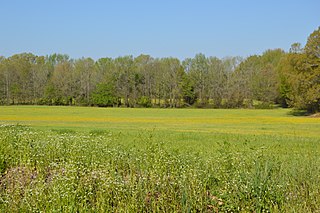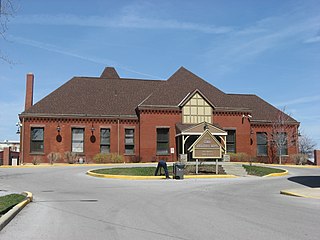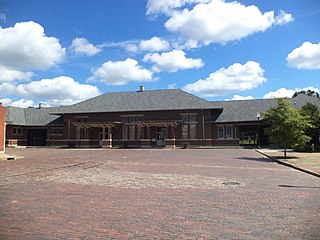
The Stone Arch Bridge is a former railroad bridge crossing the Mississippi River at Saint Anthony Falls in downtown Minneapolis, Minnesota. It is the only arched bridge made of stone on the entire Mississippi River. It is the second oldest bridge on the river next to Eads Bridge. The bridge was built to connect the railway system to the new Union Depot, which at that time was planned to be built between Hennepin Avenue and Nicollet Avenue. The bridge was completed in 1883, costing $650,000 at the time. 117 Portland Avenue is the general address of the historic complex.

Shiloh National Military Park preserves the American Civil War Shiloh and Corinth battlefields. The main section of the park is in the unincorporated community of Shiloh, about nine miles (14 km) south of Savannah, Tennessee, with additional areas located in the city of Corinth, Mississippi, 23 miles (37 km) southwest of Shiloh and the Parker's Crossroads Battlefield in the city of Parkers Crossroads, Tennessee. The Battle of Shiloh began a six-month struggle for the key railroad junction at Corinth. Afterward, Union forces marched from Pittsburg Landing to take Corinth in a May siege, then withstood an October Confederate counter-attack.

The Gulf, Mobile and Ohio was a Class I railroad in the central United States whose primary routes extended from Mobile, Alabama, and New Orleans, Louisiana, to St. Louis and Kansas City, Missouri, as well as Chicago, Illinois.

The Siege and Battle of Corinth Sites are a National Historic Landmark District encompassing surviving elements of three significant American Civil War engagements in and near Corinth, Mississippi. Included are landscape and battlefield features of the siege of Corinth, the Second Battle of Corinth, and the lesser known Battle of Hatchie's Bridge on October 5, 1862. The district includes features located in both Alcorn County, Mississippi and Hardeman County, Tennessee, with some of the former preserved as part of Shiloh National Military Park. It was designated a landmark in 1991.

The Kalamazoo Transportation Center is an Intermodal train and bus station in downtown Kalamazoo, Michigan. It is the second-busiest Amtrak station in Michigan, after Ann Arbor. The Kalamazoo Transportation Center serves as the main hub for Kalamazoo Metro local buses, and also serves intercity buses operated by Greyhound and Indian Trails.

Union Station, also called the Meridian Multi-Modal Transportation Center, is an intermodal transportation center in Meridian, Mississippi. The station is located at 1901 Front Street in the Union Station Historic District within the larger Meridian Downtown Historic District, both of which are listed on the National Register of Historic Places. Consisting of a new addition and renovated surviving wing of the 1906 building, Union Station was officially dedicated on December 11, 1997. It is a center of several modes of passenger transportation, including Amtrak train service on the Norfolk Southern rail corridor, Greyhound, and other providers of bus services.

The President Street Station in Baltimore, Maryland, is a former train station and railroad terminal. Built in 1849 and opened in February 1850, the station saw some of the earliest bloodshed of the American Civil War (1861-1865), and was an important rail link during the conflict. It is the oldest surviving big-city railroad terminal in the United States.

The William Aiken House and Associated Railroad Structures make up a National Historic Landmark District in Charleston, South Carolina, that contains structures of South Carolina Canal and Railroad Company and the home of the company's founder, William Aiken. These structures make up one of the largest collection of surviving pre-Civil War railroad depot facilities in the United States. The district was declared a National Historic Landmark in 1963.

Central of Georgia Depot and Trainshed is a former passenger depot and trainshed constructed in 1860 by the Central of Georgia Railway (CofG) before the outbreak of the American Civil War. This pair of buildings was declared a National Historic Landmark in 1976, a listing that was expanded in 1978 to the old Central of Georgia Railway Savannah Shops and Terminal Facilities.

The Apex Union Depot is a historic railroad station located on Salem Street in downtown Apex, North Carolina and is the centerpiece of the Apex Historic District. Constructed in 1914 by the Seaboard Air Line Railroad, the building shared service with the Durham and Southern Railway, but now houses the Apex Visitor Center, Apex Chamber of Commerce, and meeting rooms rented out for special events. A 37-foot Louisville and Nashville Railroad caboose is located beside the building. In December 1998 the Apex Union Depot was listed on the National Register of Historic Places.

The history of Meridian, Mississippi begins in the early 19th century before European-American settlement. Originally settled by the Choctaw Indians, the land was bought by the United States according to the Treaty of Dancing Rabbit Creek in 1830. The city grew around the intersection of the Mobile and Ohio Railroad and the Southern Railway of Mississippi and developed a largely rail-based economy. Although much of the city was burned down in the Battle of Meridian during the American Civil War, the city was rebuilt and entered a "Golden Age." Between about 1890 and 1930, the city was the largest in Mississippi and a leading center for manufacturing in the Southern United States. After the decline of the railroading industry in the 1950s, the city's economy was devastated, resulting in a slow population decline. The population has continued to decline as the city has struggled to create a new, more modern economy based on newer industries. In the past 20 years or so, Meridian has attempted to revitalize the city's economy by attracting more business and industry to the city, most specifically the downtown area.
A Mississippi Landmark is a building officially nominated by the Mississippi Department of Archives and History and approved by each county's chancery clerk. The Mississippi Landmark designation is the highest form of recognition bestowed on properties by the state of Mississippi, and designated properties are protected from changes that may alter the property's historic character. Currently there are 890 designated landmarks in the state. Mississippi Landmarks are spread out between eighty-one of Mississippi's eighty-two counties; only Issaquena County has no such landmarks.

There are nine historic districts in Meridian, Mississippi. Each of these districts is listed on the National Register of Historic Places. One district, Meridian Downtown Historic District, is a combination of two older districts, Meridian Urban Center Historic District and Union Station Historic District. Many architectural styles are present in the districts, most from the late 19th century and early 20th century, including Queen Anne, Colonial Revival, Italianate, Art Deco, Late Victorian, and Bungalow.

Lima station is a historic former train station in Lima, Ohio, United States. Built for the Pennsylvania Railroad in 1887, it is a brick Queen Anne structure that rests on a sandstone foundation. The Lima station is located on the former Pennsylvania Railroad's mainline between New York City and Chicago. Lima station was formerly served by the Pennsylvania Railroad's Pennsylvania Limited and by its flagship Broadway Limited daily passenger trains between New York City and Chicago in its later years.

The Herndon Depot Museum, also known as the Herndon Historical Society Museum, is located in the town of Herndon in Fairfax County, Virginia. Built in 1857 for the Alexandria, Loudoun & Hampshire Railroad, the depot later served the Richmond and Danville Railroad, the Southern Railway and the Washington and Old Dominion Railroad. In 1875, the original shed was replaced with the current depot.
The numerous historic hotels in Meridian, Mississippi, provide insights into the city's growth and expansion, both in the late 19th and early 20th centuries and into the modern age. Many hotels were built in downtown Meridian in the early 1900s to provide lodging for passengers of the railroad, which was essential to the city's growth at the turn of the 20th century. Two of these historic hotels–the Union Hotel, built in 1910, and the Lamar Hotel, built in 1927–have been listed on the National Register of Historic Places.

Albany Railroad Depot Historic District is located at the 100 block of West Roosevelt Avenue in Albany, Georgia, United States, and is governed by the Thronateeska Heritage Center, a 501(c)3 not-for-profit organization incorporated in 1974 for the purpose of historic preservation and science education in Southwest Georgia. The Heritage Plaza includes the Tift Warehouse, the Union Station depot, the Railway Express Agency building and Albany's last remaining brick street and is listed in the National Register of Historic Places (NRHP).

The Toledo and Ohio Central Railroad Station, today named Station 67, is a union meeting space and event hall located in Franklinton, near Downtown Columbus, Ohio. Built by the Toledo and Ohio Central Railroad from 1895 to 1896, it served as a passenger station until 1930. It served as an office and shelter for Volunteers of America from 1931 to 2003, and has been the headquarters of International Association of Fire Fighters Local 67, a firefighters' union, since 2007. The building was placed on the National Register of Historic Places in 1973. During its history, the building has experienced fires and floods, though its relatively few owners have each made repairs and renovations to preserve the building's integrity. The building is the last remaining train station in Columbus.

The Downtown Corinth Historic District in Corinth, Mississippi is a 31-acre (13 ha) historic district. It was listed on the National Register of Historic Places in 1993, at which time it included the majority of Corinth's downtown commercial buildings. The street plan of the area was laid out in 1855 by surveyors Houston Mitchell (1824-1877) and Hamilton Mask, who intended for the city to be named "Cross City". The plan conformed to the rights-of-way granted to the Memphis & Charleston Railroad and the Mobile and Ohio Railroad lines; the downtown area evolved from c.1855 to c.1941.

Magnolia station is a historic railway station located at 101 E. Railroad Avenue, in Magnolia, Mississippi. The depot was placed on the National Register of Historic Places in 1984 as The Depot and was designated a Mississippi Landmark in 2006.




















